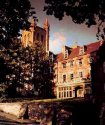Quick Links
Year
Seven
The students are selected from a large number of
different Primary Schools and thus come to B.C.S.
with a wide and varying background of mathematical
experience. It
is expected that each student should arrive with
a knowledge of their multiplication tables and this
knowledge is applied through aural mental arithmetic
tests and written work. Calculators
are not used in the first year, other than when a
project or open-ended-task demands their use. A
great deal of emphasis is placed on mental arithmetic
and considering the reasonableness of an answer. The
core text book is ‘Maths Now! Red/Blue Orbit’ by
Murray, but is supplemented by individual teacher’s
worksheets and projects. The
aim of this year is to ensure that each student has
a good understanding of Number, Algebra, Shape and
Space and Handling Data, to an appropriate level
but, by the use of differentiation, each student
is also stretched and discovers some new and interesting
areas of mathematics. TOP
Year
Eight
The year is set with one top set, a middle set and
a smaller third set. The
aim is to build on the foundations of last year and,
by setting, stretch the most able students whilst
giving more time to the weaker students in the smaller
third set. There
continues to be an emphasis on non-calculator work
and the use of aural mental arithmetic tests. The
students all cover the same topics, but the more
able students study in greater depth and at a quicker
pace than the others. The core text is ‘Maths
Now! 2 Red Orbit’ by Murray. There
are various projects throughout the year, including
the very popular ‘popcorn project’, where
students form companies to design popcorn containers
and advertise their product to the rest of the year. TOP
Year
Nine
There are three distinct sets, following a similar
core scheme of work. The top set covers work in a
little more depth and the bottom set is smaller to
allow for greater individual attention. Most
of the work is still non-calculator and builds up
to level seven of the National Curriculum in all
four key areas. We
do not, however, specifically prepare the students
for SATs, as the students are not entered. The core text book has been changed this year, to continue
the schemes of lower down the school: ‘Maths
Now! 3 Red Orbit’ by Murray. The students
have an opportunity to experience both a pure and
statistical piece of GCSE coursework, each over a
two-week period. This enables the students
to develop skills of organising and structuring their
work and problem solving techniques as they choose
their own paths of investigation. TOP
Year
Ten
There are three distinct sets, with the top two
sets initially working towards the Higher Tier of
entry of the GCSE EdExcel course and set three working
towards the Intermediate Tier of entry. The
core texts are introduced this year, to continue
the schemes further down the school. We
also wanted a series that used one text book per
year, to give the students a sense of progression
and to allow them to take the books home. Thus
the core texts are ‘Maths Now GCSE’ by
Murray. The
intention is to work through the syllabus, with the
text book as the main resource, in two years with
particular attention paid to the coursework and preparations
for the non-calculator paper. To
this end the scheme of work allows for two short
practice coursework attempts and is tailored towards
the first, statistical, piece of coursework at the
end of the academic year. The
continuing use of five minute, non-calculator, spot
tests will improve the students abilities to work
without a calculator. TOP
Year
Eleven
The three classes are also working towards the new
GCSE EdExcel exams, but with the top set aiming at
the Higher Tier of entry and sets two and three working
towards the Intermediate Tier of entry. The
second piece of coursework takes place in October,
during a three-week period that is interrupted by
work experience and half term. This
second piece of coursework is a pattern-spotting
or problem solving task. The
marks for the two pieces of coursework are added
and form 20% of the final GCSE mark.
The Higher Tier of entry results in
grades from A* to C and the Intermediate Tier of
entry in grades from B to E.

